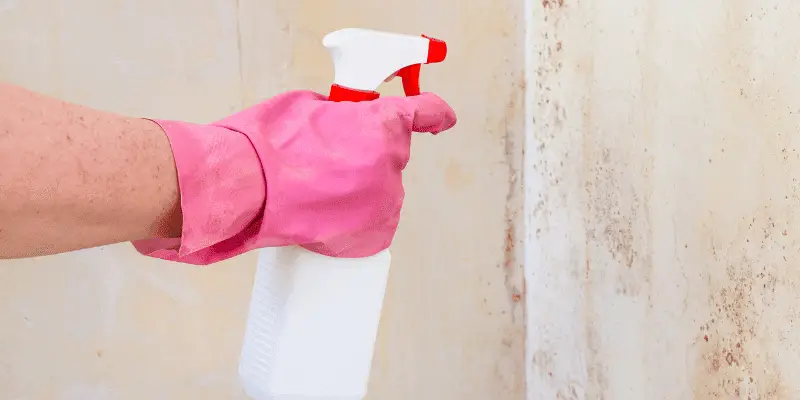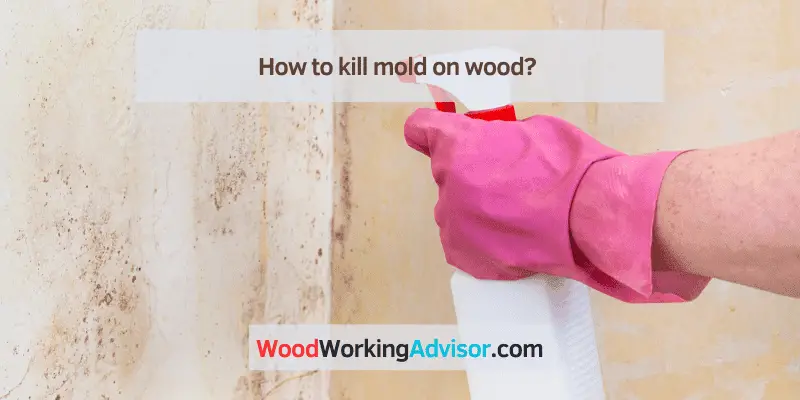Mold on wood can be a persistent and unsightly problem, but with the right approach, you can effectively eliminate it and prevent its return. If you don’t know how to kill mold on wood, this guide is for you. It can be achieved by following the simple guidelines.
The best way to kill mold on wood is to start by addressing the source of moisture. Then, use a mixture of water and detergent to scrub the affected wood surface. For tougher cases, mix a solution of equal parts white vinegar and water or hydrogen peroxide and water. Finally, apply the solution.
In this guide, I’ll explore safe and efficient methods for killing mold on wood surfaces, ensuring a healthier and mold-free environment in your home.
Spray To Kill Mold On Wood:
To effectively kill mold on wood using a spray, combine a solution of white vinegar or hydrogen peroxide with water in a spray bottle. For white vinegar, use a 1:1 ratio of vinegar to water.
For hydrogen peroxide, use a 3% solution mixed with water in a 1:1 ratio. Liberally spray the affected wood surface with the solution, ensuring it is completely covered. Allow it to sit for about 10-15 minutes to penetrate and kill the mold.
Then, scrub the wood with a brush or sponge to remove the mold. Rinse the area with clean water and thoroughly dry it. These natural solutions are effective and safe alternatives to chemical mold-killing sprays.
Vinegar To Kill Mold On Wood:
Vinegar is an effective natural remedy to kill mold on wood. White vinegar, with its mild acidity, can help eliminate mold and its spores. Pour undiluted white vinegar into a spray bottle and liberally spray the affected wood surface. Allow it to sit for an hour or more to ensure the vinegar penetrates the mold.
Then, scrub the area with a brush to remove the mold. Rinse with clean water and thoroughly dry the wood. The acidity in the vinegar not only kills the mold but also helps prevent its return.
It’s a safe and eco-friendly method for treating mold on wood surfaces, but it may leave a vinegar scent that dissipates over time.
Kill Black Mold On Wood:
To effectively kill black mold on wood, you can use a mixture of white vinegar and water or hydrogen peroxide and water. For white vinegar, use a 1:1 ratio of vinegar to water, and for hydrogen peroxide, use a 3% solution mixed with water in a 1:1 ratio.
Spray the affected wood surface generously with the chosen solution and allow it to sit for about 10-15 minutes to penetrate and kill the mold. Afterward, scrub the area with a brush or sponge to remove the mold.
Rinse with clean water and ensure the wood is thoroughly dried to prevent mold from returning. Be sure to use proper protective gear like a mask and gloves when dealing with black mold, as it can be harmful to health.
Best Spray To Kill Mold On Wood:
The best spray to kill mold on wood is a commercial mold and mildew remover specifically designed for this purpose. These products are formulated to effectively eliminate mold, including black mold, from wood surfaces. Look for one with a dual-action approach, combining mold-killing chemicals and surfactants for better penetration.
Always follow the manufacturer’s instructions for application and safety precautions. Additionally, ensure proper ventilation and wear protective gear like a mask, gloves, and goggles.
After applying the spray, scrub the wood to remove the mold, then rinse and dry the area thoroughly. This method can be more potent than DIY solutions for stubborn or extensive mold infestations.
Bleach Solution To Kill Mold On Wood:
A bleach solution can effectively kill mold on wood. To make the solution, mix one part bleach with ten parts water (1:10 ratio) in a well-ventilated area, and wear protective gear like gloves and a mask.
Liberally apply the bleach solution to the affected wood surface, ensuring it’s completely covered. Allow it to sit for about 15 minutes to penetrate and kill the mold. Then, scrub the wood with a brush to remove the mold.
Rinse the area with clean water and thoroughly dry it. Be cautious when using bleach, as it can discolor wood and emit strong fumes. Ensure the room is well-ventilated during and after the process.

FAQ
What Kills Black Mold On Wood?
To effectively kill black mold on wood, a solution of hydrogen peroxide and water is a potent choice. Mix a 3% hydrogen peroxide solution with water in a 1:1 ratio. Spray the affected wood surface generously, allowing it to sit for about 10-15 minutes to penetrate and kill the mold.
Then, scrub the area with a brush or sponge to remove the mold. Rinse with clean water and ensure the wood is thoroughly dried to prevent mold from returning.
Hydrogen peroxide is a safer and less corrosive alternative to bleach, making it a reliable option for eliminating black mold on wood while minimizing potential damage to the surface. Always wear protective gear when dealing with mold.
Does bleach kill mold on Wood?
Bleach can effectively kill mold on wood surfaces, but its effectiveness can depend on various factors. While bleach can eliminate surface mold, it might not be as effective in penetrating porous materials like wood, potentially leaving behind microscopic mold spores that could cause regrowth.
Using bleach on wood can affect its appearance and integrity. It can discolor the wood and weaken its structure over time. When using bleach, ensure proper ventilation, and wear protective gear.
Consider combining bleach with other mold-killing solutions for better results. To prevent future mold growth, address the moisture source and ensure the wood is thoroughly dried after treatment.
Does vinegar kill mold on Wood?
Yes, vinegar can effectively kill mold on wood. White vinegar, with its mild acidity, is a natural remedy that can help eliminate surface mold and its spores on wood. Simply pour undiluted white vinegar into a spray bottle and liberally spray the affected wood surface.
Allow it to sit for an hour or more to ensure the vinegar penetrates the mold. Then, scrub the area with a brush to remove the mold. Rinse with clean water and thoroughly dry the wood.
Vinegar’s acidity disrupts the mold’s cell structure, effectively killing it. It’s a safe and eco-friendly option for treating mold on wood surfaces, with the added benefit of inhibiting future mold growth.
Does Bleach Kill Black Mold On Wood?
Bleach can effectively kill black mold on wood surfaces, but it might not completely eradicate all the mold spores. While it can eliminate surface mold, the porous nature of wood can make it challenging for bleach to penetrate deeply, potentially leaving behind microscopic mold spores that could lead to regrowth.
Moreover, using bleach on wood can discolor the surface and weaken its structural integrity over time. It’s crucial to wear protective gear and ensure proper ventilation when using bleach.
For a more comprehensive approach, consider combining bleach with other mold-killing solutions and addressing the moisture source to prevent future mold growth.
Does Hydrogen Peroxide Kill Mold On Wood?
Yes, hydrogen peroxide can effectively kill mold on wood surfaces. A 3% hydrogen peroxide solution, when mixed with water in a 1:1 ratio, can be used to treat mold on wood. Liberally spray the affected wood surface with this solution and let it sit for about 10-15 minutes, allowing it to penetrate and kill the mold.
Then, scrub the area with a brush or sponge to remove the mold. Rinse with clean water and ensure the wood is thoroughly dried to prevent mold from returning. Hydrogen peroxide is a less harsh and corrosive alternative to bleach, making it a safer and reliable choice for eliminating mold while minimizing potential damage to the wood. Always wear protective gear when dealing with mold.
What To Use To Kill Mold On Wood?
To effectively kill mold on wood, you can use several options. A mixture of white vinegar and water (1:1 ratio) or a solution of hydrogen peroxide and water (1:1 ratio) can be applied by spraying the affected area, allowing it to sit for 10-15 minutes, and then scrubbing off the mold.
Commercial mold and mildew removers designed for wood surfaces are also effective and convenient. Additionally, a mixture of baking soda and water can be used to scrub away mold.
Always ensure the wood is thoroughly dried to prevent mold regrowth. For stubborn cases, consult with a professional for a thorough assessment and remediation.


